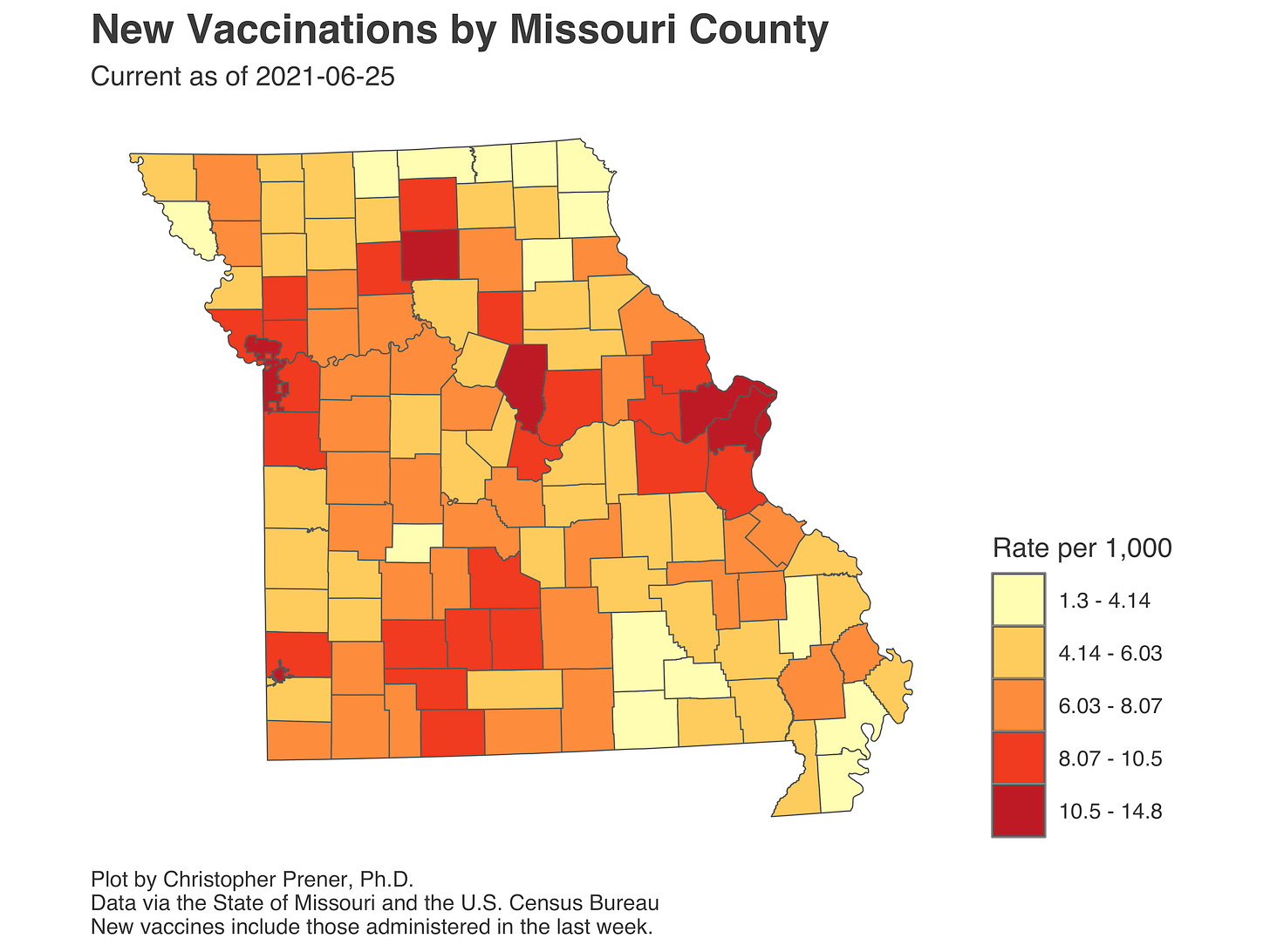This will be my last newsletter of June and has little good news. Vaccination rates continue to be low, even as Missouri’s rate of new cases and hospitalizations top state trends in the United States. Throughout Southwestern Missouri, county-level rates of new cases are not just high, but among the twenty highest counties in the United States for counties with more than 10,000 residents. All of these shifts are being fueled by the Delta variant and should command everyone’s attention. - Chris
COVID-19 by the Numbers
Total cases in MO: 629,759 (+5,233 from last Friday)
7-day average of new cases per day in MO: 747.57 (+148.86 from last Friday)
Counties with the highest per capita rates (per 100,000) of new cases per day this past week:
Dallas (57.15 per 100,000), Worth (56.02), Webster (54.39), Grundy (52.65), Taney (48.04), Laclede (47.88), Linn (44.55), Joplin (42.22), and Audrain (40.50)
Total deaths in MO: 9,872 (+39 from last Friday)
7-day average of new deaths per day in MO: 5.57 (-0.71 from last Friday)
Percent of all Missourians initiating vaccination: at least 39% (no change from last Friday)
Percent of all Missourians completing vaccination: at least 34% (+1% point from last Friday)
Case and mortality numbers are current as of Thursday, June 24th. Vaccination numbers are current as of Friday, June 25th. Additional statistics, maps, and plots are available on my COVID-19 tracking site.
Illness Trends in the Past Week
There have been two big shifts since my last email. The first is relatively good news - the sky-high per capita rates we saw in Linn, Livingston, and Putnam counties have receded. Even here, however, we need to hedge, though. Linn County may have seen its rate drop, but among counties with more than 10,000 residents nationally, its rate of new cases is still number thirteen.
Outside of these decreases, there is little good news to report. Despite dropping cases in these formerly superlative counties, the absolute number of new cases in “outstate” Missouri has continued to climb steadily. The number of new cases we’re experiencing both statewide and outside our two largest metropolitan areas is roughly equivalent to where things stood in February. They the reason that Missouri’s rate of new cases is the highest in the United States.
Looking at the list with counties with the highest rates above tells you much about where things are deteriorating - Southwest Missouri, especially around Springfield and Joplin. Every county that I follow closely in these two metropolitan areas is experiencing increases. More populous jurisdictions, including Taney, Dallas, Webster, and Joplin, all are among the top twenty counties nationally in terms of their seven-day averages of new cases.
The same upward trends are also being observed around Lake of the Ozarks. Like the other counties I’ve named so far, Laclede County is among the top twenty counties with populations greater than 10,000 nationally when it comes to its current seven-day average of new cases.
Collectively, cases in this part of Missouri are translating to increased hospitalization rates. Like our new case rate, hospitalizations statewide in Missouri are the highest in the United States right now. The rates in the Joplin and Springfield metro, in particular, rose steadily over the first eleven days of June (the most recent data we have from HHS).
Conditions in Missouri, especially around Springfield, have received national media attention. We have an increasing volume of evidence suggesting that the Delta variant is fueling the increases here and elsewhere in Missouri.
Vaccination Trends in the Past Week
There is little news to report on vaccinations, with the top county-level rate over the last week lower than it was a week before. The geographic patterns are largely the same - St. Louis, Columbia, and Kansas City metros continue to have some of the highest vaccination rates. However, you can see that vaccination rates also stand out in areas being hard hit by new cases right now - Joplin, Springfield, and Northern Missouri. Despite these areas with higher rates, the overall trend of vaccinations remains sharply down from April, when it was at its peak in Missouri.
It is worth remembering that the time to get vaccinated is well before cases start to rise. Especially if you live in an area where cases are not yet rising, do not be lulled into thinking things will stay that way. Getting the vaccination process started now is an essential step to take.
If you like what you see here and don’t already, please subscribe!









